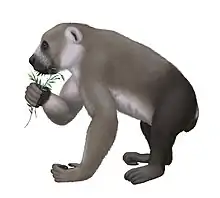Agerinia
Agerinia is a genus of adapiform primate that lived in Europe during the early Eocene.[3] Fossils have been found in the Grès d'Assignan, Lignites de Soissonais, and Calcare d'Agel Formations of France, the Corçà and Escanilla Formations of Spain and the Kuldana Formation of Pakistan.
| Agerinia Temporal range: Early Eocene ~ | |
|---|---|
| Scientific classification | |
| Domain: | Eukaryota |
| Kingdom: | Animalia |
| Phylum: | Chordata |
| Class: | Mammalia |
| Order: | Primates |
| Suborder: | Strepsirrhini |
| Family: | †Notharctidae |
| Subfamily: | †Cercamoniinae |
| Genus: | †Agerinia Crusafont-Pairo & Golpe-Posse 1973 |
| Species | |
References
- Joan Femenias-Gual; Raef Minwer-Barakat; Judit Marigó; Salvador Moyà-Solà (2016). "Agerinia smithorum sp. nov., a new early Eocene primate from the Iberian Peninsula". American Journal of Physical Anthropology. 161 (1): 116–124. doi:10.1002/ajpa.23014. PMID 27306700.
- Joan Femenias-Gual; Raef Minwer-Barakat; Judit Marigó; Miquel Poyatos-Moré; Salvador Moyà-Solà (2017). "Agerinia marandati sp. nov., a new early Eocene primate from the Iberian Peninsula, sheds new light on the evolution of the genus Agerinia". PeerJ. 5: e3239. doi:10.7717/peerj.3239. PMC 5410143. PMID 28462042.
- Gebo 2002, p. 27.
Bibliography
- Gebo, D.L. (2002). "Adapiformes: Phylogeny and adaptation". In Hartwig, W.C. (ed.). The Primate Fossil Record. Cambridge University Press. ISBN 978-0-521-08141-2. OCLC 47254191.
This article is issued from Wikipedia. The text is licensed under Creative Commons - Attribution - Sharealike. Additional terms may apply for the media files.

